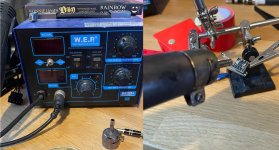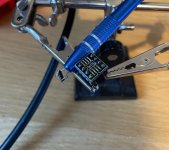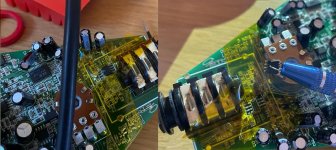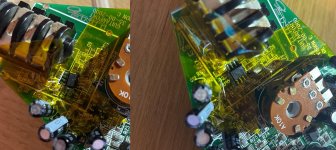Yeah I'm probably going to order a few and see if I can socket it. Unfortunately Mouser charge £12 for UK delivery so I'm thinking of seeing if there's enough space to socket it first. If not, I'll just install the one I've bought so far (which happens to be 1642) and post the results. If there's ANY noticeable difference, then I can widen said experiment.OPA1677 is 64p, OPA1678 is 75p, both in stock at Mouser
It shouldn't be too hard to remove that SOP. There are some components near but I've had worse PCBs to rework. 🙂
For some reason I can't quote your message @NIXIE62 but yes, that's how I plan to protect the components surrounding it. I've got decent experience in SMD rework as I spent a period repairing VW ECU's which all tend to use the same SOIC IC's (24C04's etc), so I developed a reasonably good technique. I've definitely had worse to play with, although there are a couple of caps and resistors I'll need to play close attention to. The key is to keep the airflow just enough that it won't sweep any surrounding components off, but also not so hot that it ultimately damages the IC.
That said, despite some high profile **** ups during my years of doing this and IC's which refused to leave the PCB due to poor manufacturing, I've never killed an IC.... and i once put one in the wrong way round! We all make mistakes 🙂
That said, despite some high profile **** ups during my years of doing this and IC's which refused to leave the PCB due to poor manufacturing, I've never killed an IC.... and i once put one in the wrong way round! We all make mistakes 🙂
So while I'm waiting for the op-amp to arrive and in the interest of sharing my ongoing experimenting and investigation with these interfaces, I've dismantled the Line6 Toneport UX2, which is an interface from the same series released a few years after the GuitarPort. The Toneport was pitched as a more upmarket recording interface and their target audience was a home studio, whereas the GuitarPort was always pitched as simply a practice tool.
The Toneport has
Dual XLR + Phantom Power
Twin Jack Input, one is padded.
VU Meters.
and some other bits and bobs that aren't included with the GuitarPort.
However, both are compatible with the same archaic Gearbox software supplied by Line6 and the patches can be shared seamlessly between the GuitarPort, TonePort and other Pod models that were released during that period.... which means I would hazard a guess that they contain the same DSP but may different amp chips? Most people don't use Gearbox anymore other than for practice. For recording, there's better guitar VST's (Guitar Rig etc).
So this is the Toneport guts'n'all.

Admittedly, I don't know where I'm looking on this board and there's a lot more components, but:
Next to the two XLR's there are
2x C082C
slightly below that is a
TL074C
140528G
In the middle, there's a AK4528VF.
And sure enough, next to the two guitar inputs is another TL072C which I find quite interesting. I'm not saying that chip alone will make or break the sound quality, but they definitely pitched these two products towards difference audiences while many of the components appear to be shared... at least from my entirely n00b'esque understanding.
There's a cluster of IC's in the middle, but I think they may be more towards the USB side of things? No idea though.
For reference, here's the full GuitarPort PB. Lots of similarity!

The Toneport has
Dual XLR + Phantom Power
Twin Jack Input, one is padded.
VU Meters.
and some other bits and bobs that aren't included with the GuitarPort.
However, both are compatible with the same archaic Gearbox software supplied by Line6 and the patches can be shared seamlessly between the GuitarPort, TonePort and other Pod models that were released during that period.... which means I would hazard a guess that they contain the same DSP but may different amp chips? Most people don't use Gearbox anymore other than for practice. For recording, there's better guitar VST's (Guitar Rig etc).
So this is the Toneport guts'n'all.
Admittedly, I don't know where I'm looking on this board and there's a lot more components, but:
Next to the two XLR's there are
2x C082C
slightly below that is a
TL074C
140528G
In the middle, there's a AK4528VF.
And sure enough, next to the two guitar inputs is another TL072C which I find quite interesting. I'm not saying that chip alone will make or break the sound quality, but they definitely pitched these two products towards difference audiences while many of the components appear to be shared... at least from my entirely n00b'esque understanding.
There's a cluster of IC's in the middle, but I think they may be more towards the USB side of things? No idea though.
For reference, here's the full GuitarPort PB. Lots of similarity!
And just like that, two 1642s have arrived. Now unfortunately I couldn't seem to find anywhere that looked reputable that were selling the ICs only, or at least had them at the time. All good places seemed out of stock. Plenty on Aliexpress and eBay from China but none on Mouser so I took a gamble on these.
Do they look legit? If so, I'll get cracking.



Worst case I will order the other chips as recommended by others from a Mouser or Digi Key.
In other news, I reckon I could just about fit a adapter socket for DIPs. Not convinced the case would close.... But that's what drilling a hole in the top is for 🙂
Do they look legit? If so, I'll get cracking.
Worst case I will order the other chips as recommended by others from a Mouser or Digi Key.
In other news, I reckon I could just about fit a adapter socket for DIPs. Not convinced the case would close.... But that's what drilling a hole in the top is for 🙂
Last edited:
Lucky guy.
We Argentines pay U$ 35 cheapest Mouser "discounted" package and are murdered at Customs 😫
Oh well.
Unfortunately Mouser charge £12 for UK delivery
We Argentines pay U$ 35 cheapest Mouser "discounted" package and are murdered at Customs 😫
Oh well.
I must admit, it's been a while since I've done an electrical project like this but i don't remember it being so expensive the last time I did. I recapped Casio MIDI guitar swapping the SMT surface mount caps with Radial electrolytic caps a few years back and it definitely cost less than £10 and I only bought either nichicon or Panasonic and there was even a few non-polarized caps in that order.
I used to go and buy components from Maplin (before it became a toy shop and closed down). Can't remember if they sold opamps or not but i seem to remember they weren't bad for resistors, caps etc. Shame it's gone 🙁 it's a completely cornered market now unless you are willing to chance Aliexpress. There's no local shops for this whatsoever, so you're either buying in bulk to make it worthwhile or paying a fortune.
I used to go and buy components from Maplin (before it became a toy shop and closed down). Can't remember if they sold opamps or not but i seem to remember they weren't bad for resistors, caps etc. Shame it's gone 🙁 it's a completely cornered market now unless you are willing to chance Aliexpress. There's no local shops for this whatsoever, so you're either buying in bulk to make it worthwhile or paying a fortune.
Any thoughts on these two?
https://www.diyaudio.com/community/threads/tl072c-upgrade-for-audio-interface.409006/post-7601697
I personally can't tell if they're fake or gen because they all look blooming identical on Google lol.
https://www.diyaudio.com/community/threads/tl072c-upgrade-for-audio-interface.409006/post-7601697
I personally can't tell if they're fake or gen because they all look blooming identical on Google lol.
Got bored, so I cracked on. Job done! I'd say if anyone is reading this and interested in having a crack themselves, it's probably somewhere in the region of intermediate difficulty wise. although I was mildly rusty with my SMD rework skills as it's been a good 2 years since I did an ECU, so it was a good thing I worked on the new amp chip first just to get my hand steady again. As always, it comes down to the prep. Plenty of kapton tape to protect the surrounding components as recommended by @NIXIE62, just the right amount of flux and just keeping a steady hand 🙂 Take time!
As there was nothing to sweep, I took a relatively high air flow and moderate temp (350 i think?) to scavenge me an OPA1642 from it's adapter board 🙂

Easy work.

There are a good four or five components in the vicinity of the IC that you want to be wary of. There are about 4 resistors and a little ceramic cap, all of which need plenty of protection, so I used a good amount of tape, dropped the airflow to avoid sweeping them off and bumped up the temperature to about 380, which is a little higher than I would usually go but seemed to do the job.

Adding the OPA1642 is the reverse. Pin 1 is the one nearest to the 1/4 jack so be mindful to put the bar at that end. I refreshed some of the kapton tape and just moved quickly. Quite often in my experience, when these reworks go wrong, time is the killer. Either you're flapping for too long and sweep a component or you burn one. I probably only had the air on it for no more than 20 seconds.

Job done. 👍

First signs, I think it sounds loads brighter and way more dynamic. I would say you can hear more of the overtones coming through... but it may be a placebo in my head. Until I do a proper A/B test, I can't be sure, so I need to work something out. What do other people do for this kind of stuff? Is there a reference WAV file I can put through it or something?
If anyone else fancies a pop at this... these interfaces go for next to nothing as they're over 20 years old, yet have an incredible 2ms latency at 128bit with no pops or distortion.

Not bad eh?
Thanks for your continued input all! I'll come back with some audio when I get chance 🙂
Edit:
The blue grabber things I bought from Aliexpress before Christmas for 90p. I've never used them before but they're fantastic. Wish I'd have them a few years ago when I was doing this with nothing but tweezers!
As there was nothing to sweep, I took a relatively high air flow and moderate temp (350 i think?) to scavenge me an OPA1642 from it's adapter board 🙂

Easy work.

There are a good four or five components in the vicinity of the IC that you want to be wary of. There are about 4 resistors and a little ceramic cap, all of which need plenty of protection, so I used a good amount of tape, dropped the airflow to avoid sweeping them off and bumped up the temperature to about 380, which is a little higher than I would usually go but seemed to do the job.

Adding the OPA1642 is the reverse. Pin 1 is the one nearest to the 1/4 jack so be mindful to put the bar at that end. I refreshed some of the kapton tape and just moved quickly. Quite often in my experience, when these reworks go wrong, time is the killer. Either you're flapping for too long and sweep a component or you burn one. I probably only had the air on it for no more than 20 seconds.

Job done. 👍
First signs, I think it sounds loads brighter and way more dynamic. I would say you can hear more of the overtones coming through... but it may be a placebo in my head. Until I do a proper A/B test, I can't be sure, so I need to work something out. What do other people do for this kind of stuff? Is there a reference WAV file I can put through it or something?
If anyone else fancies a pop at this... these interfaces go for next to nothing as they're over 20 years old, yet have an incredible 2ms latency at 128bit with no pops or distortion.
Not bad eh?
Thanks for your continued input all! I'll come back with some audio when I get chance 🙂
Edit:
The blue grabber things I bought from Aliexpress before Christmas for 90p. I've never used them before but they're fantastic. Wish I'd have them a few years ago when I was doing this with nothing but tweezers!
Last edited:
- Home
- Design & Build
- Electronic Design
- TL072C upgrade for audio interface